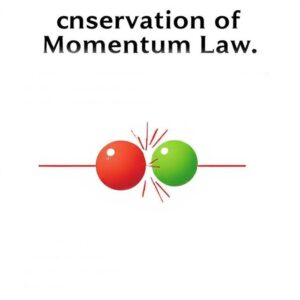Conservation Laws are fundamental principles in physics that tell us that certain quantities remain constant (or conserved) in an isolated system. This means these quantities don’t change unless something acts on them. We’ll cover Energy, Momentum, and Angular Momentum one by one.
1. Conservation of Energy:
Energy is the ability to do work. It can come in many forms, such as kinetic energy (energy of motion), potential energy (stored energy), and others like thermal (heat) and chemical energy.
- The Conservation of Energy Law states that energy cannot be created or destroyed; it can only change from one form to another. The total amount of energy in a closed system (one that doesn’t exchange energy with the outside) always stays the same.

Example:
Imagine a roller coaster. When the roller coaster is at the top of a hill, it has potential energy because of its height. As it goes down, the potential energy turns into kinetic energy (energy of motion). When it reaches the bottom, it has its maximum speed, so most of its energy is now kinetic. However, the total energy (potential + kinetic) remains the same throughout the ride.
2. Conservation of Momentum:
Momentum is the product of an object’s mass and velocity. Essentially, it’s how hard it would be to stop an object in motion. Momentum depends on both how fast something is moving and how heavy it is.
- The Conservation of Momentum Law says that the total momentum of a system remains constant as long as no external forces are acting on it. In simpler terms, if two objects collide, the total momentum before and after the collision will be the same, even though the momentum of each object individually might change.
Example:
Think about two ice skaters on a frictionless ice rink. If one skater pushes off the other, they both start moving in opposite directions. Before the push, their total momentum was zero (because they weren’t moving). After the push, both skaters have momentum, but the total momentum still equals zero because the momentum gained by one skater is exactly balanced by the momentum of the other.
3. Conservation of Angular Momentum:
Angular momentum is the rotational equivalent of linear momentum. It depends on the rotational velocity of an object and how its mass is distributed (i.e., how far the mass is from the axis of rotation). It tells us how much “spin” an object has.
- The Conservation of Angular Momentum Law states that if no external torque (rotational force) acts on a system, the total angular momentum of the system remains constant.
Example:
Imagine a figure skater spinning. When the skater pulls their arms in, they start spinning faster. This happens because when they reduce their body’s distance from the center of rotation (their axis of spin), their angular momentum must stay the same. To compensate, their rotational speed increases. If no external forces act on them, the total angular momentum before and after pulling their arms in stays the same.
Summary of the Conservation Laws:
- Conservation of Energy: Energy in a system can change forms (kinetic, potential, etc.), but the total energy remains constant unless energy is added or lost from the system.
- Conservation of Momentum: In a closed system (no external forces), the total momentum before and after an interaction (like a collision) remains constant.
- Conservation of Angular Momentum: If no external rotational force is applied, the total angular momentum of a rotating system remains constant.
These laws are fundamental to understanding the behavior of objects in the universe, from the smallest particles to the largest galaxies. They help explain how things move, interact, and change over time.











